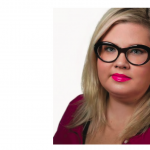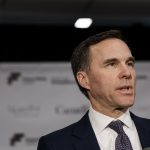Why the parliamentary press gallery still matters
Despite all the attempts to limit access to information at the federal level, journalists in the press gallery are still breaking important stories. Parliamentary press gallery president Laura Payton reflects on why Canadians should still want a strong journalism community in Ottawa as the message control gets tighter.
Journalists listen to a statement by Pierre Poilievre at Parliament Hill. Photo courtesy of Laura Payton
By Laura Payton
Members of the parliamentary press gallery are in a privileged position. We interact every day with important people and have access that most Canadians don’t. It’s part of our jobs to ask pointed questions and sometimes raise the impertinent view so that we can tell others what’s going on.
It’s a responsibility most journalists take seriously. We love our jobs. We love digging through stacks of documents, questioning a statement that doesn’t make sense and finding the right expert to shed light on new policies—all with the goal of explaining to Canadians what their government is doing. Those are our small ways of trying to help our communities.
If you’ve got enough going on by working, driving your kids to soccer and caring for an elderly parent, you don’t have time to read a 242-page bill on changes to electoral law or sit through dozens of hours of committee study. That’s why we have our jobs.
Last month, members at our annual general meeting passed a motion asserting our right to ask questions at photo ops. It hardly seems like something that needs saying in a democracy, but some politicians have tried to ban questions during photo ops. That wouldn’t normally be a problem, but when those politicians also hold press conferences in Ottawa just a handful of times a year, photo ops are our only access.
Related content on J-Source:
- Live blog: Does the parliamentary press gallery matter?
- 4.1 PR professionals for every journalist in Canada
- The Golden Age of Journalism? You’ve got to be kidding!
Our motion is directed at all parliamentarians because, as we look ahead to the 2015 federal election, we fear the trend won’t reverse itself, whether the election keeps the Conservatives in power or brings in a new government.
It’s one thing to decide not to answer a question. But it’s unacceptable to try to impose limits on our ability to ask questions.
Long-time journalists say this tightening control has worsened over decades. But the past few years have seen almost unimaginable restrictions. For example, technical briefings on major trade deals and legislation now take place with no background information offered and little access to civil servants to explain the policy they crafted.
Those are just the ways we look for facts. Trying to get comments, never mind interviews, from MPs can be a whole other challenge. Some MPs take the back door, and cabinet meetings are no longer announced, leaving journalists fewer chances to go directly to the people in charge of vital files. Many cabinet ministers’ communications staff don’t even activate their voicemail, forcing reporters to try to reach them through email or even Twitter.
It’s hard to find the reason for a new policy when you can’t reach the minister’s staff to request an interview, the minister leaves through the back door and the departmental staff aren’t allowed to do briefings.
We think that’s an unfortunate way to try to communicate important ideas and changes to Canadians. These policies are passed by the people we elect, and pay, and which govern how we live our lives and build our businesses.
The press gallery has been part of Parliament since Confederation. There are references to the press gallery above the House of Commons dating back to 1867, and the plans for a rebuilt Centre Block after the Feb. 3, 1916, fire that destroyed it include the gallery and the hot room— a work room for reporters, down the hall from that gallery overlooking the House.
Despite all of these attempts at limiting access to information, journalists in the press gallery—and beyond—are still breaking important stories. Robocalls, the Senate scandal and even a set of tariff increases in the 2013 budget that may raise the cost of everyday items—each of those stories comes from journalists on Parliament Hill asking questions. We’re there because Canadians can’t be. We’re there to cut through the reams of useless information to find the bits that matter. We’re there to ask the questions for others who don’t have the same access. And we’re there every day so that we follow a thread over time to know better what is honest and what is simply one person’s version of the truth.
That’s the value of the press gallery.
Laura Payton has worked as a journalist on Parliament Hill since 2007, filing to online, radio and TV platforms. She became president of the Parliamentary Press Gallery in March 2014. Follow her on Twitter @laura_payton. Photo courtesy of CBC.
Related content on J-Source:
- Globe public editor: Why endorsing Harper doesn’t mean not criticizing him
- What is the relationship between democracy and media?
- Book Review: Duffy is a well-crafted take on the journalist-turned-senator’s rise and fall
Tamara Baluja is an award-winning journalist with CBC Vancouver and the 2018 Michener-Deacon fellow for journalism education. She was the associate editor for J-Source from 2013-2014.





